There’s no doubt that car seats are extraordinary in terms of increasing your child’s safety and comfort, particularly during long flights.
Flying with a car seat makes sense, even though it will be a hassle to drag around the airport. It is without a doubt the single most important safety travel gear for a baby.
Here are some tips to save you from the hassle that comes with using a car seat on a plane.
PS. Click here to see our guide to finding the best airplane car seat.
Our Traveling with a Car Seat on a Plane Guide

Thinking about traveling with a car seat on a plane? Here is a great guide with loads of tips and information.
Do You Need a Car Seat for Plane Travel?
Flying with a baby car seat may be a complete hassle, but it is the safest way to fly with a baby.
Without it, you will need to hold your baby during the most dangerous phases of air travel – take-off and landing!
And the only thing to secure baby will be a pretty pathetic lap belt that slips and falls around way too easily.
Do you HAVE TO USE a baby seat on the plane? No, legally you are not required to use a car seat.
But if your baby’s safety is of utmost importance to you, then we highly recommend you drag along your car seat to use on the plane!
The American FAA does strongly recommend that you use an approved child restraint device when traveling with infants less than 2-years old.
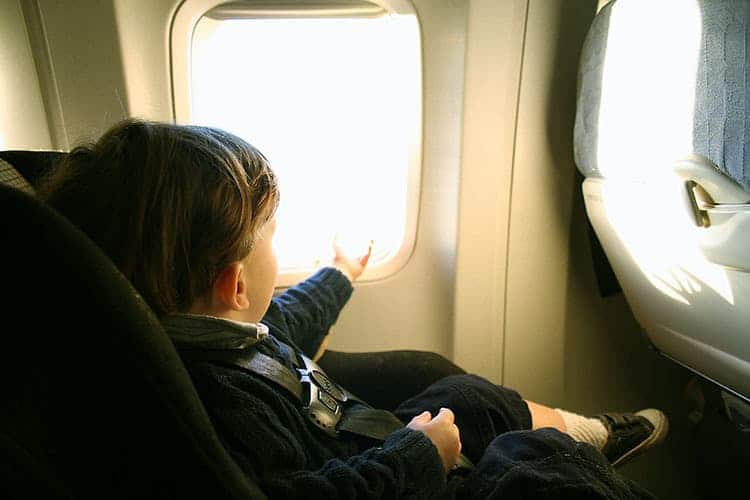
Here are some pros and cons of using a taking a car seat on a plane trip:
Pros
- An infant car seat will protect your baby from slight incidents such as hard landings and serious turbulence.
- Using a car seat makes traveling much easier and more comfortable not just for the baby, but also for the parent. Click here to get more tips on how to make your flight easier with your baby.
- Car seats can recline which means that your baby or toddler can fall asleep more easily.
- Your child is familiar with a car seat and therefore will feel more secure and at peace in one.
- Flying with a toddler car seat will help you stay sane when your child hits the busy toddler years.
Cons
- The stress involved in bringing a car seat to the airport and fixing it properly in the plane, as well as a lot of misinformation revolving around car seats during flights, can be intimidating and frustrating.
- Just like your travel suitcase can get damaged during travels, there are also chances that your car seat can get a few scratches here and there.
- You will need to purchase an additional seat for the car seat.
Features to Look for in Your Plane Travel Car Seat
Set on bringing a car seat on the plane for your baby? Did you know that you can only use certain types of car seats on the plane?
Thinking through which car seat is right for your flight or trip is essential in ensuring that things go as smoothly as possible during your travels.
Imagine how frustrated you could be if you check in at the airport and you find out that your car seat is not FAA-approved.
Consequently, here are some features to look for in an air-travel car seat:
– FAA-Approved
One of the most important features to look for in your baby seat for plane travel is to check and see whether it’s FAA approved or not.
A car seat HAS to be FAA approved, otherwise, the crew won’t allow you to use it.
How do you find out if your car seat is FAA approved?
Have a look at the sticker on the side of the seat and see if it says “This restraint is certified for use in motor vehicles and aircraft.”
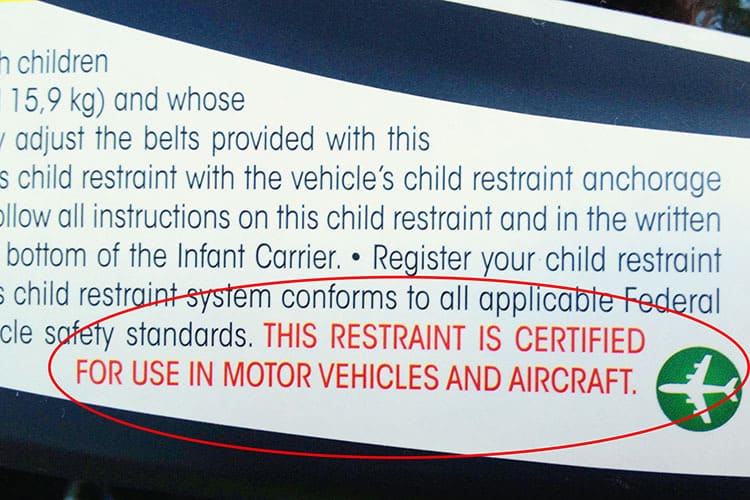
FAA Requirements
For a child less than 40 lbs. : Secure your child in an FAA-approved car seat for the duration of the flight.
Follow the manufacturer’s instructions. This would typically be in the rear-facing position (for kids under 20 lbs and forward-facing for kids over 22 lbs.
For a child 22 lbs – 44 lbs. : For babies and toddlers at this age, you could either use an approved car seat or you could choose to secure them in the airplane seat in a Child Safety Harness Device.
The Cares restraint is the only FAA-approved child airplane harness system that is allowed to be used during take-off, landing as well as in flight.
More than 40 pounds: Kids can use an airplane seat belt, however, many parents typically keep their child in a car seat until around 3.5 years.
>>> Click here to see a list of the best FAA-approved car seats for plane travel.
– Car Seat Size
The fact that your car seat is FAA approved is not a guarantee that it will fit on every airplane.
It’s, therefore, crucial to check your car seat and its dimension and compare it to the dimension of your airline’s seats.
Car seats often vary from 16 inches to 21 inches so you should call the airline or check your airline’s seat sizing on SeatGuru just to be sure.
Nonetheless, a car seat that measures 16 inches wide should have no problem fitting on typically any airline seat.
In short, always go for a car seat that has a slim design.
A slim car seat is not only easy to carry around but can also quickly and easily fit through the security scanner, fit down the aisles on planes as well as fit on the bulkhead seats.
– Your Car Seat should be Lightweight
A car seat for traveling on a plane needs to be lightweight.
Going for a lightweight and compact car seat will make your travel easier on all fronts at the airport, as well as to and from the airport.
We prefer a car seat that is around 10 lbs.
Inform the Airline of Your Intentions to Bring Your Car Seat
There are a lot of inconsistencies regarding flying with a car seat. This is because there are varying internal policies regarding car seats and these may differ from airline to airline and they differ from country to country.
It’s therefore, important to do extensive homework, which pretty much involves calling their airline and checking with them on their car seat policies.
You should inform them in advance of your intentions to travel with a car seat and provide details such as FAA certification, model, and size.
You should also request the airline to add these details on your booking notes and if possible, grab written confirmation stating that it’s okay for you to bring the car seat on board – print this out and take it with you on the plane.
Always re-confirm with them 24 hours before departure.
How to Choose the Best Seats on the Flight for Your Car Seat
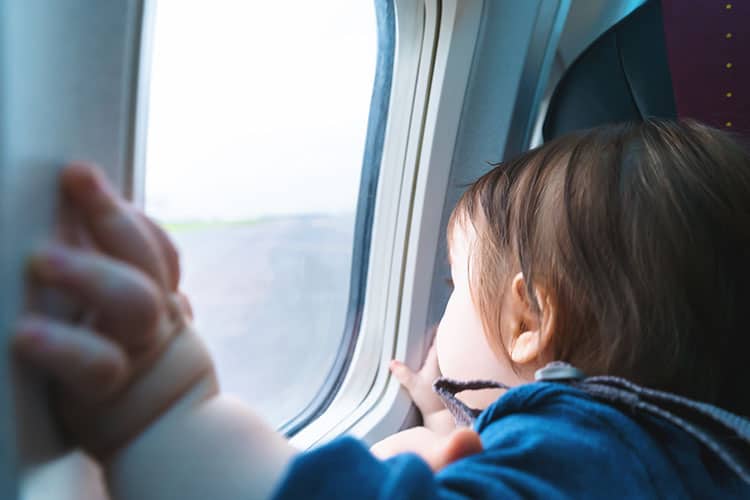
Car seats are not allowed in seats where they’d block the exit paths of any other passenger in the row.
With that in mind, you should choose a window seat for your car seat. This is essential in the sense that it will allow other passengers in the row to enter and exit freely.
Flying with an infant car seat that needs to be installed in the rear-facing position?
You should be well aware a rear-facing installed car seat might block the passenger in front from reclining.
You can consider booking the front seat for one of the parents, to ensure that no other passengers are disgruntled by not being able to recline.
Another thing to consider when choosing the best seat on the plane is the fact that bulkhead seats are often narrower than normal seats because of the tray tables that are structured in the armrests.
Bulkhead seats are great as they give you more room, and it also means that you won’t have any issues with reclining seats. But I would only recommend you book these seats if you purchase 16” car seats.
Getting Around the Airport with the Car Seat
Getting through the airport with your baby, luggage and a car seat in tow is obviously challenging. As a result, consider these solutions:
– Car Seat Travel Cart
You can quickly and easily attach your car seat to the car seat travel cart and just roll your car seat around the airport with ease.
It’s even better that you can secure your baby in the car seat while on the cart.
Better still, you can fold the car seat travel cart and place it in the overhead compartment once on the plane.
We have a full guide on the best car seat travel carts that you can browse here.
>>> Click here to browse some great car seat trolley options on Amazon.
– Car Seat Backpack
Carrying a car seat in a backpack may seem weird, but it is an easy way to move around the airport whilst still having your hands free to deal with check-in procedures as well as baggage and security checks.
In most cases, these backpacks have shoulder straps, as well as wheels on the bottom for rolling.
>>> Click here to browse through the best car seat backpacks.
– Car Seat Belt
You can also use a belt to attach your car seat to your carry-on luggage.
This is essential in making sure that your luggage and the car seat remain together at all times during check-in.
Car seat belts are small and easily stored.
>>> Click here to browse through the best car seat straps.
Using and Installing the Car Seat on the Plane
There are rules regarding flying with rear-facing car seats. It’s always important to call the airline and confirm the requirements before bringing your car seat.
While many airlines may not accept that you interfere with the passenger in front, keep in mind that it’s your right to keep the car seat rear-facing so long as it’s within the required height and weight limit.
Installing the Car Seat
Many airlines often give parents with children the chance to board the plane first.
Even with that, you should still be an expert in installing the car seat to do it properly.
Installing a rear-facing car seat is done the way you’d do it in a car. You should recline the plane’s seat back then thread the seatbelt on the plane’s seat through the bottom of the car seat and clip it onto the seatbelt’s buckle.
You should make sure that it’s tightened before raising the plane’s seat back.
A tip would be to hop onto YouTube and search for your car seat brand + plane travel and see if anyone has shared an installation video specific to your car seat.
FAQ
1. Can You Use a Booster Seat on the Plane?
Most boosters are not FAA approved and therefore, cannot be during take-off and landing on the plane.
Some airlines will, however, let you use the booster seat during the flight (except during turbulence).
Best to give the airline you will be flying with a quick call to check.
Regardless, we still do travel with our own portable booster seats so that we can use them in public transport or rental cars once we get to our destination.
2. Are There Alternatives to Car Seats?
The Safety Harness is definitely the only thing that comes to mind as an alternative to car seats on the plane.
It’s a simple set of straps that can be easily connected to the plane’s seat.
The best part is that it’s FAA approved and more convenient than having to carry a bulky car seat.
The Harness is highly recommended, but keep in mind that you are allowed to use it only if your baby is weighing 22 pounds or more.
>>> Click here to see prices for the Harness.
Have you made up your mind about whether you would like to travel with a car seat on the plane?
Hop over to our baby travel guide to help you find the best places to travel with an infant.

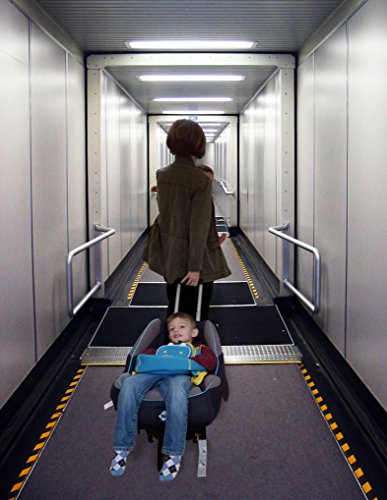
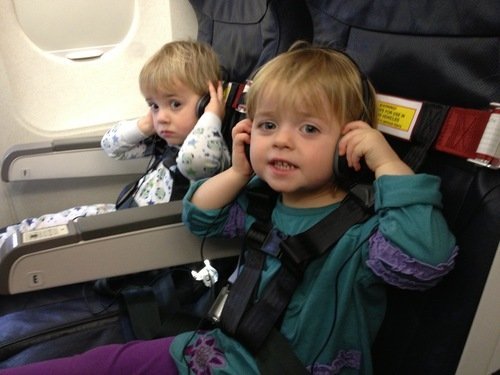
Great article!
“For a child less than 40 lbs. : Secure your child in an FAA approved car seat for the duration of the flight. Follow the manufacturer’s instructions. This would typically be in the rear-facing position.”
Did you perhaps mean “For a child less than 22 lbs”?
Hi, I just clarified this in the description. Basically kids up to 40lbs is recommended to sit in a car seat. Under 22lbs is rear-facing and over 22lbs in forward facing. (see a document by Qantas here as an example) Kids over 40 lbs should be in their own seat. Hope it makes it easier to understand now 🙂
thanks for this article! I had no idea you could do any of these things. I have two toddlers aged 3 &4 – one is in a booster and the other in a car seat. I find that my kids might sleep better in the car seats on the plane. Your article doesn’t talk about sleep at all. What are your thoughts? My kids usually crash out on long drives in the car and I find their car seats have good head support for sleeping hence why i think using them on the plane would be magical! I wanted to go overseas soonish but was hesitant because of the sleep factor on long flights ( I live in Australia so all of our flights anywhere take a long time).
Yes, the car seats are fabulous for sleeping because 1. the kids have already claimed the car seat as ‘their space’ and they feel safe and comfy in it. The car seats can usually recline, which makes it great for sleeping and as you said it has the sides for head support. IF you find that your kids sleep well in cars in their seats then go for it! Our little hate hates the car and always cries (sighs) – so she feels much safer sleeping on us in the plane (but it makes it harder for us to sleep when she is on us).